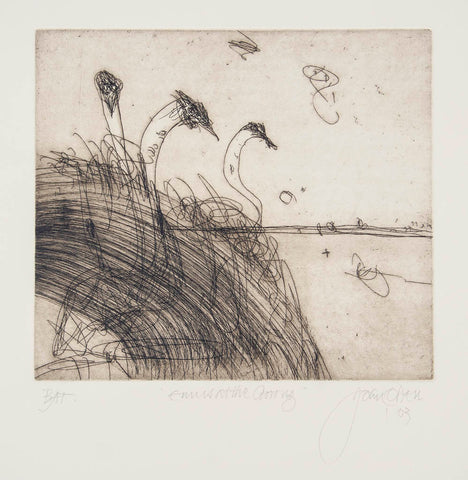On Tuesday night, John Olsen passed away at age ninety-five surrounded by family. His death marks the closing of an era, the loss of an artist whose line is embedded in the genome of Australian identity. Olsen won the Wynne, Sulman and Archibald prizes, leading a sixty-year career that expanded the boundaries of landscape art, uniting forms of life grand and small.
John Olsen - 'Monkeys'
Humble Beginnings
Olsen was born in Newcastle in 1928 to a clothes buyer and tailor. He grew up in the shadow of the Great Depression without access to art, music or books. Despite this, he was born an artist, going on to study at the Julian Ashton School while cleaning offices at night. He then enrolled at East Sydney Technical College where he was taught by John Passmore and later on, sponsored by art collector Robert Shaw, moved to Europe to study printmaking.
It was at an artist colony in Mallorca, however, that Olsen met poet and historian Robert Graves whose advice came to characterise his practice: “You can paint pretty pictures all your life but without metaphor you’ve got nothing. Read avidly and embrace poetry.” When Olsen returned to Australia in 1960, he embodied Graves’s words, commencing the hugely successful ‘You Beaut Country’ series.

John Olsen protesting the Archibald in 1953 with fellow students.
'Bonnard at Le Cannet'
Life and Loss
While there is variety in Olsen’s subjects – frogs, people, paella – he was best known for his landscapes, remarking “There is so much to look at and observe about the Australian landscape, how it varies from tropical to the coastal fringe, and the interior. It’s so multiple. It’s a beautiful animal, that landscape.”
In this great expansiveness, Olsen found notes of sublimity, whimsy and threat. In 1974, he visited Lake Eyre in South Australia after it flooded, witnessing a profound rush and receding of life that art historian Patrick McCaughey argued thereforth “occupied Olsen’s Dreaming.”
'Edge of the Void'
The Edge of the Void Portfolio, a series of six etchings inspired by this trip, is as Graves would have observed, landscape with metaphor – steeped in the paradox that nothingness, or the void, has an active presence. Before Olsen’s eyes, Lake Eyre rolled from a vacant salt pan to wet with life, it ate and rebirthed itself; life improbably sprung from the void.
'Emus at the Coorung'
With a Twinkle
As often as Olsen’s work was profound, it was humorous. He took delight in all forms of life, marvelling at the awkward gait of the frog, the spindly giraffe and mischievous monkey. On his trip to Lake Eyre, he and naturist Vincent Serventy capsized in a storm that sent paints skyward and sandwiches seaward. Rather than discourage him, the moment tickled him – “Gee, I’m very small-time here,” laughed Olsen.
He was a painter, printmaker, draughtsman, poet, cook and champion swimmer. His achievements were vast, embellished by a 1970 mural for the newly opened Sydney Opera House based on Kenneth Slessors’s poem ‘Five Bells’. The mural still feels contemporary.

John Olsen's 'Five Bells' mural at the Sydney Opera House.
Later this year, Olsen’s work will be projected on the Opera House’s sales for Sydney Vivid. “I’m a lucky boy,” he said of the honour.
'Cat Kitchen I'
Olsen’s absence will be keenly felt in Australia’s cultural life. As Director of the National Gallery of Australia, Nick Mitzevich, told the Sydney Morning Herald, his work held a “quintessential Australianness.” In the squirm of a tadpole, Australian desert or the “beautiful bath” of Sydney Harbour, Olsen’s line lives on, inspiring and delighting with equal abandon.
Vale John Olsen.

Explore our John Olsen collection.





